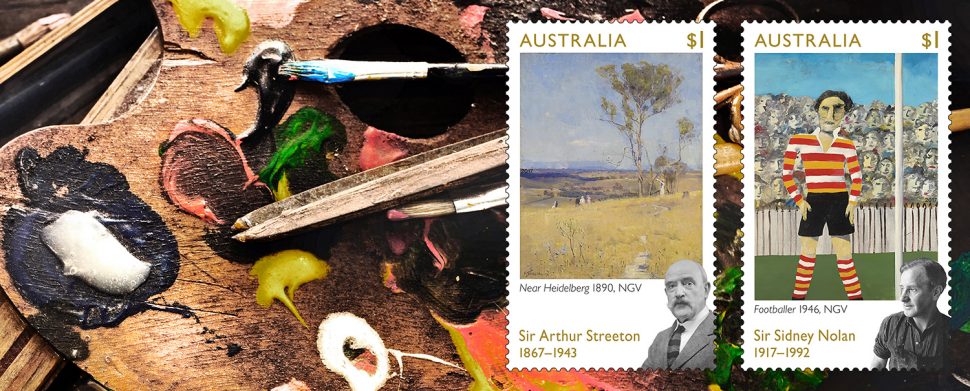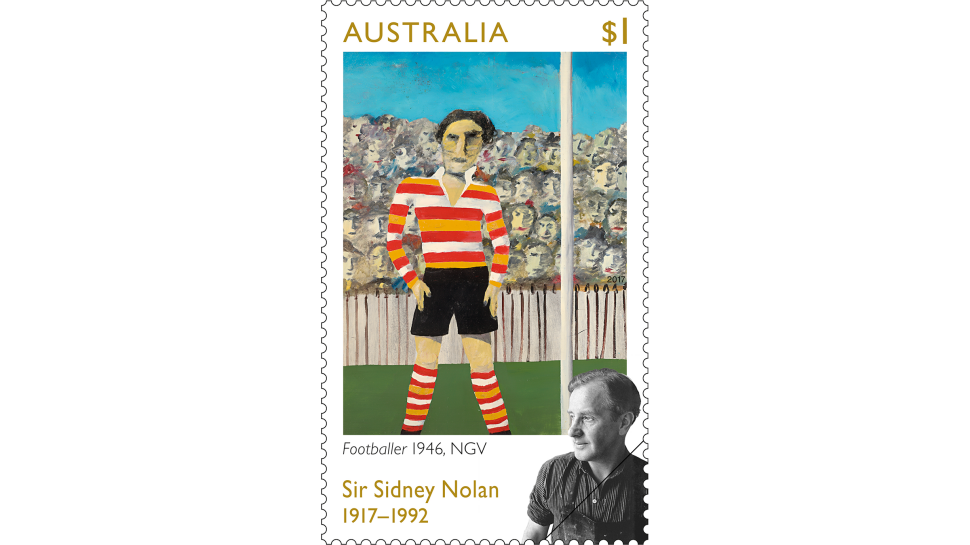Sir Arthur Ernest Streeton (1867–1943) and Sir Sidney Robert Nolan (1917–1992) were leading Australian artists of their day and are much-admired icons of Australian art.
Arthur Streeton and Sidney Nolan is a commemorative issue of two stamps, which will be released on 30 March 2017. The stamp issue celebrates the sesquicentenary of the birth of Arthur Streeton and the centenary of the birth of Sidney Nolan. Designed by Lynette Traynor of the Australia Post Design Studio, the stamps present well-known paintings by the artists – Near Heidelberg (1890) by Arthur Streeton and Footballer (1946) by Sidney Nolan – alongside photographic portraits.
Sir Arthur Streeton and Near Heidelberg (1890)
Sir Arthur Ernest Streeton (8 April 1867 – 1 September 1943) is one of Australia’s best loved artists. Born 150 years ago in Duneed, near Geelong in Victoria, he came to prominence alongside fellow Australian Impressionist painters including Frederick McCubbin, Tom Roberts and Charles Conder in the 9 by 5 Impressions exhibition of 1889. In 1891, the painting Golden summer, Eaglemont (1889) was exhibited at the Royal Academy of Arts in London to widespread acclaim. Between 1897 and 1920 Streeton lived in London, visiting France and Italy and also making return trips to Australia where he staged successful exhibitions of his work. He was appointed an official Australian war artist during the World War I. In 1920, Streeton returned permanently to Australia, where he continued painting landscapes as well as more intimate subjects such as still-life compositions and his own garden in the Melbourne suburb of Toorak. He retired to Olinda, in the Dandenong Ranges, in 1938, where he died, on 1 September 1943.
The oil on canvas work, Near Heidelberg, now in the collection of the National Gallery of Victoria, was painted in 1890. With a blue and golden palette evoking a warm, sunny day, it shows well-dressed men and women walking down to the Yarra River.
The painting is indicative of the painted scenes of the Heidelberg School, which is considered the first important art movement in Australia and the first to truly capture the rugged beauty and interesting light and palette of the Australian landscape. With the other artists of the Heidelberg School, which included Frederick McCubbin and Tom Roberts, Streeton painted from camps at Box Hill and Heidelberg, where he could paint outdoors, or en plein air in the manner of the Barbizon School and French Impressionists. This work was painted while Streeton was living at the nearby Mont Eagle estate, now the Melbourne suburb of Eaglemont.
The term “Heidelberg School” is said to have originated in July 1891, when visiting American art critic Sidney Dickinson wrote a review of an exhibition of paintings by Arthur Streeton and Walter Withers in The Australian Critic:
“Both these artists are of that practice which may be called, for purposes of distinction, the 'Heidelberg School' for their work has been done chiefly in this attractive suburb, where, with others of like inclination, they have established a summer congregation for out-of-door painting.”
The photographic portrait is one of a series of almost full-length formal portraits by Jack Cato, taken near the end of Streeton’s life, probably around 1940. At this stage he was recognised as one of the country’s pre-eminent artists. These photographs are held in the collection of State Library Victoria.
Sidney Nolan and Footballer (1946)
Sir Sidney Robert Nolan OM AC (22 April 1917 – 28 November 1992) was one of Australia's leading artists of the 20th century. Nolan was born 100 years ago in the working-class suburb of Carlton in Melbourne and studied at Prahran Technical College and the National Gallery of Victoria art school. He is best known for his depictions of tragic narratives in Australian history, including bushranger Ned Kelly, the shipwrecked Eliza Fraser and explorers Burke and Wills. Nolan’s now iconic paintings of the Kelly Gang have become symbolic of Australian history and identity.
Other subjects include the Australian landscape, the suburb of St Kilda in Melbourne, African animals, Antarctica and Greek mythology. His paintings are in the modernist idiom, often rich in colour, with discordant forms evoking strong emotion. In the early 1950s Nolan moved to Europe, returning to Australia only periodically. After a successful and much lauded international career, he died in London in 1992.
Footballer, now in the collection of the National Gallery of Victoria, was painted in enamel on composition board in 1946, around the same time that Nolan started the first works of his Ned Kelly series. It depicts an Australian rules footballer before a crowd of fans. The jersey colours are intentionally generic, but the figure is thought to represent a St Kilda player, although opinion varies as to his identity. With its bold colours and forms, the painting is characteristic of Nolan’s expressionist realism of the 1940s.
Nolan painted Footballer at Heide, the artists’ colony and home of John and Sunday Reed, now the Heide Museum of Modern Art in Bulleen, a suburb of Melbourne. Nolan was one of the leading figures of the Heide Circle that collected around art patrons John and Sunday Reed and was also a member of the Angry Penguins group (an Australian literary and artistic avant-garde movement of the 1940s). When Heide opened as a public art museum in 1981 (following its purchase by the State Government of Victoria), the inaugural exhibition presented Ned Kelly paintings by Sidney Nolan.
The photographic portrait of Nolan, by Axel Poignant, was taken in Nolan’s Putney studio in London, in 1964, when the artist was 47. In the background is Lady Interrupted 1964 – Adelaide Lady, one of a series of paintings depicting well-dressed ladies Nolan observed in the South Australian capital earlier that year.
The Arthur Streeton and Sidney Nolan stamp issue is available from 30 March 2017, online, at participating Post Offices and via mail order on 1800 331 794, while stocks last.
The stamp issue and associated products will also be available for purchase at the Melbourne 2017 International Stamp Exhibition, from 30 March to 2 April 2017, at the Caulfield Racecourse, Melbourne while stocks last.
See also our article on the Gallery series of stamps and postal stationery.
*This article was produced at the time of publication and will not be updated.



